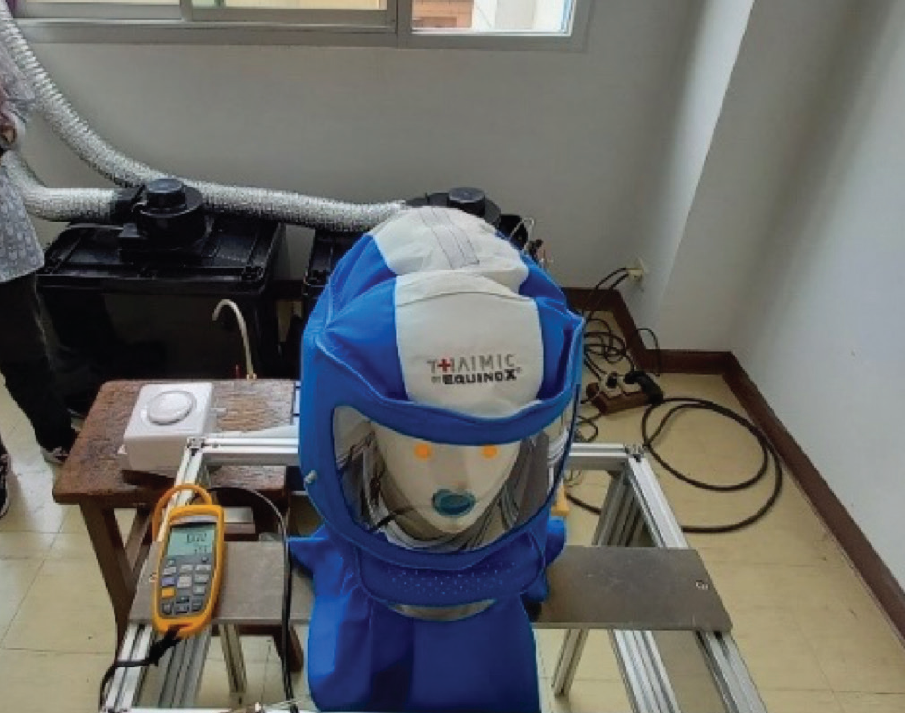การทดสอบสมรรถนะอุปกรณ์ป้องกันทางเดินหายใจจ่ายอากาศบริสุทธิ์แบบหมวกคลุมศีรษะที่พัฒนาขึ้นภายในประเทศสำหรับใช้ในสถานการณ์การแพร่ระบาดโคโรน่าไวรัส 2019 ในประเทศไทย
DOI:
https://doi.org/10.60136/bas.v12.2023.701คำสำคัญ:
อุปกรณ์ป้องกันทางเดินหายใจจ่ายอากาศบริสุทธิ์, โคโรน่าไวรัส 2019, ชุดป้องกันส่วนบุคคลบทคัดย่อ
วิกฤตการณ์แพร่ระบาดโคโรน่าไวรัส 2019 (COVID-19) ในประเทศไทย เมื่อต้นปี 2563 ทำให้เห็นว่าชุดป้องกันส่วนบุคคล (Personal Protective Equipment, PPE) มีความสำคัญมากกับบุคลากรทางการแพทย์ โดยเฉพาะอุปกรณ์ป้องกันทางเดินหายใจจ่ายอากาศบริสุทธิ์ หรือ PAPR ซึ่งเป็นอุปกรณ์ที่บุคลากรทางการแพทย์ใช้ป้องกันการติดเชื้อจากผู้ป่วยได้อย่างมีประสิทธิภาพ และในสถานการณ์ที่ไม่สามารถจัดหาอุปกรณ์ PAPR ได้เพียงพอต่อความต้องการ ได้มีหลายหน่วยงานพัฒนา PAPR เป็นการเร่งด่วน เพื่อให้บุคลากรทางการแพทย์มีความเชื่อมั่นสูงสุดในความปลอดภัยของอุปกรณ์ กรมวิทยาศาสตร์บริการ จึงจัดทำข้อกำหนดคุณลักษณะ/มาตรฐานผลิตภัณฑ์อุตสาหกรรม และพัฒนาห้องปฏิบัติการทดสอบ โดยได้นำผลการประเมินความเสี่ยงจากบุคลากรทางการแพทย์มาใช้เป็นแนวทางในการพัฒนาการทดสอบอุปกรณ์ป้องกันทางเดินหายใจจ่ายอากาศบริสุทธิ์ 3 รายการสำคัญ ได้แก่ 1. การรั่วซึมเข้าสู่ภายใน (total inward leakage) 2. แหล่งจ่ายอากาศ (air supply) และ 3. ความต้านทานการหายใจ (breathing resistance)
วัตถุประสงค์ของโครงนี้เป็นการทดสอบสมรรถนะทั้ง 3 ด้านข้างต้นของอุปกรณ์ PAPR ที่ผลิตในประเทศไทยในช่วงที่ประเทศไทยขาดแคลนอุปกรณ์ PPE ในช่วงการแพร่ระบาดโคโรน่าไวรัส 2019 ว่าเป็นตามที่เกณฑ์กำหนดหรือไม่ และเปรียบเทียบกับ PAPR ที่นำเข้าจากต่างประเทศ ผลการทดสอบพบว่าอุปกรณ์ PAPR ที่ผลิตในประเทศ มีประสิทธิภาพเทียบเท่ากับตัวอย่างอ้างอิงที่นำเข้าจากต่างประเทศ และมีความสามารถในการนำไปใช้ในการปฏิบัติงานของบุคลากรทางการแพทย์ในพื้นที่ที่มีการแพร่ระบาดของโรคติดต่อทางเดินหายใจได้เป็นอย่างดี
References
British Standard Institution (BSI). Respiratory protective devices-powered filtering devices incorporating a helmet or a hood-requirements, testing, marking. BS EN 12941:1998/A2:2008 (Amendment). United Kingdom: BSI; 2008.
British Standard Institution (BSI). Respiratory protective devices-power assisted filtering devices incorporating full face masks, half masks or quarter masks-requirements, testing, marking. BS EN 12942:1999. United Kingdom: BSI; 1999.
International Organization for Standardization (ISO).Respiratory protective devices-methods of test and test equipment-Part 1: Determination of inward leakage. ISO 16900-1:2014. Geneva, Switzerland: ISO; 2014.
The National Institute for Occupational Safety and Health (NIOSH). The National Personal Protective Technology Laboratory (NPPTL). Certificate standards approves air-purifying respirators in accordance with the requirements of title 42 code of federal regulations. Part 84 (42 CFR 84). Pittsburgh, PA: NPPTL; 2020.
กรมวิทยาศาสตร์บริการ. ข้อกำหนดคุุณลักษณะอุุปกรณ์ปกป้องทางเดินหายใจจ่ายอากาศบริสุุทธิ์์แบบหมวกคลุุม ครอบศีรษะสำหรับบุุคลากรทางการแพทย์. DSS 2-2563. กรุุงเทพฯ: กรมวิทยาศาสตร์ บริการ; 2563.
สำนักงานมาตรฐานผลิตภัณฑ์อุุตสาหกรรม (สมอ.). มาตรฐานผลิตภัณฑ์อุุตสาหกรรมอุุปกรณ์ปกป้อง ทางเดินหายใจจ่ายอากาศบริสุุทธิ์แบบหมวกคลุุมศีรษะ. มอก. 3191-2564. กรุุงเทพฯ: สมอ.; 2564.
International Organization for Standardization (ISO).Medical devices-Quality management systems-Requirements for regulatory purposes. ISO 13485:2016. Geneva, Switzerland: ISO; 2016.

Downloads
เผยแพร่แล้ว
How to Cite
ฉบับ
บท
License
Copyright (c) 2023 กรมวิทยาศาสตร์บริการ

This work is licensed under a Creative Commons Attribution-NonCommercial 4.0 International License.








